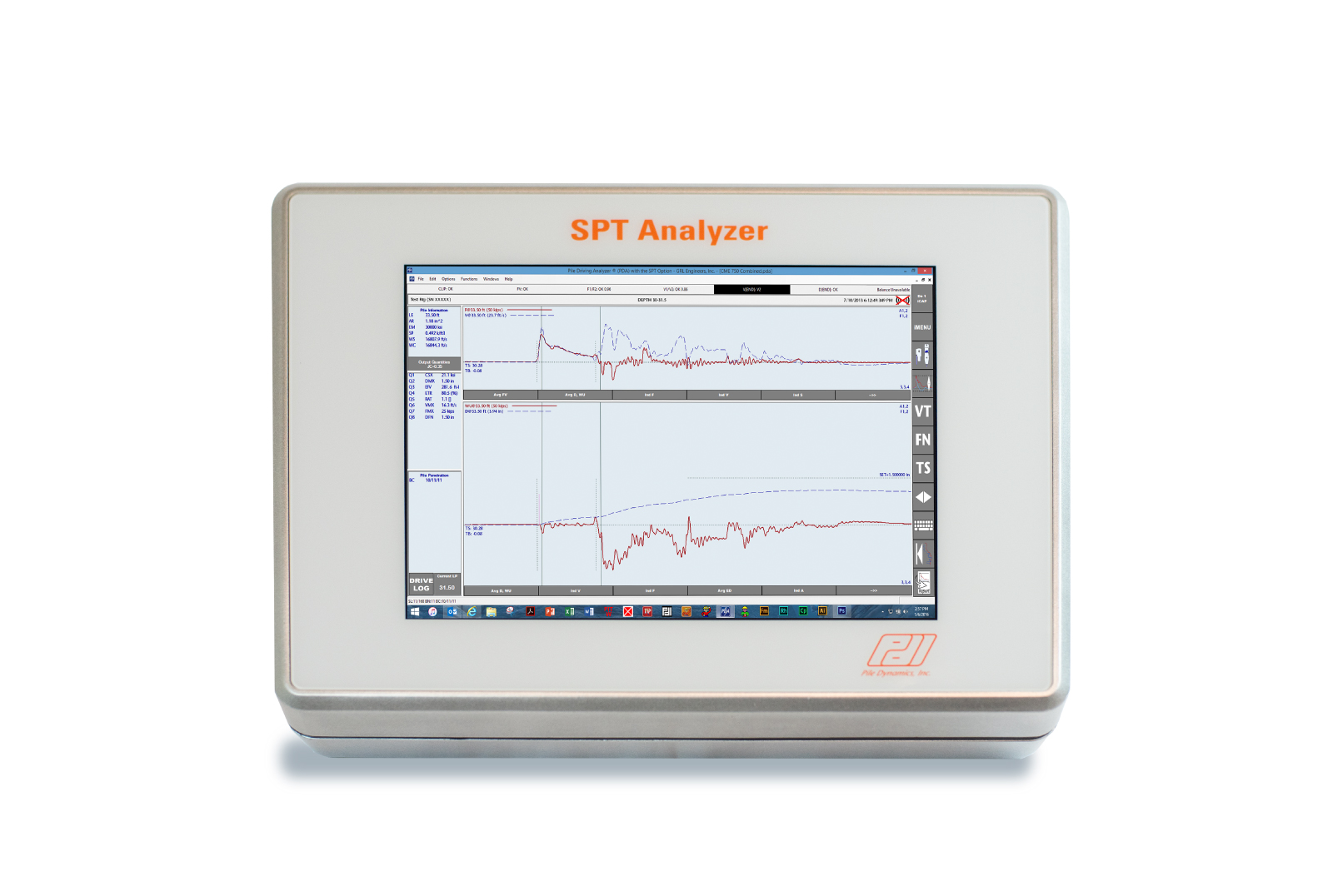What is SPT?
The Standard Penetration Test (SPT) is a widely employed soil exploration tool that involves using a SPT hammer to drive a split barrel sampler at the bottom of a drill string to obtain soil samples. The number of blows required to penetrate the last
300mm (1ft) is the “N value”, which is related to soil strength.
Several different types of SPT hammers are used to conduct Standard Penetration Tests. Their varying efficiencies influence the N value. The measured N value is normalized by multiplying it by the ratio of the measured energy transferred to the rod to 60% of the theoretical potential energy. The normalization compensates for the variability of the efficiencies of different SPT hammer types, and improves the reliability of soil strength estimates used in geotechnical applications.
The SPT Analyzer is furnished with a 0.6 m sub assembly (or section) of an SPT rod (AW, NW or other type) instrumented with
2 strain gage bridges, and precisely calibrated by Pile Dynamics. Once in the field, two accelerometers are bolted to the rod section. The instrumented section is inserted at the top of the drill string between the hammer and the existing sampling rod. The rod is connected to the SPT Analyzer. Smart Sensor technology allows the SPT Analyzer to read the rod instrumentation, obtaining the sensor calibration and rod cross sectional area. These quantities are input to the SPT Analyzer automatically without the operator having to enter them. This significantly simplifies the initial test setup. The strain gages and accelerometers obtain the force and velocity signals necessary for the calculation of transferred energy as the SPT hammers drive the instrumented rod into the ground. The energy is displayed in real time on the SPT Analyzer screen. The latest model of SPT Analyzer responds to multi touch gestures and have numerous color schemes available, making things like adjusting time scale or display to better view data in the field much simpler than previously. A pre-programmed set of output quantities tailored to SPT calibration is presented to the user, who can, however, modify it to fit a particular project need. Data
quality checks are available.
The SPT Analyzer is compliant with . recommends normalizing results from any SPT test using energy measurements. When these tests are performed to determine the liquefaction potential of sands, not only recommends but mandates the normalization. states that the only acceptable method of determining energy for normalization of N values is by force and velocity measurements.
Technical Specification
Physical
- Size: 320 X 250 X 68 mm (12.6 x 9.8 x 2.7 inches)
- Weight: 5 Kg (11 lbs)
- Temperature range: 0 to 40°C (32 to 104° F) operating; -20 to 65°C (-4 to 149° F) storage
- Display: 26.4cm (10.4”), sunlight readable, resolution 1024 X 768
- Built in capacitive touch screen
- Video Outputs: HDMI
- Power: 4-hour continuous data collection battery pack, 12 VDC car battery, or 100-240 VAC. Extra battery pack supplied.
- Charging time: 6-hour maximum
Electronic
- Microsoft Windows® 10 Operating System
- 128 GB SSD internal drive
- Ethernet port
- 4 USB ports
- Analog signal conditioning filtering (frequency response) 5 KHZ (-3 dB)
- 16-bit A/D converter with sampling frequency of 10.24 MHz
- 4 channels with effective digitizing frequency of up to 100 KHz resulting in user selectable total sample time 82 to 205 milliseconds
- Basic unit accuracy 2%
Functional
- Built in calibration test function
- 4 channels of traditional (cabled) data acquisition, universal (strain or acceleration on any channel)
- Compatible with traditional (cabled) Smart Sensors
- Automatic balancing of signals and signal conditioning
- Digital (software) integration of acceleration
- Signal conditioning for force and acceleration have similar frequency response
- Internal calibration check of strain and acceleration
- Signal amplification capability
Other
- Operates in English, SI, or Metric units
- Optional external USB keyboard, mouse, and WiFi (802.11b,g,n) available
- Includes both soft side carry-on luggage case and hard transit case
- Equipped for remote technical support using SiteLink®
- Optional TeamViewer desktop sharing software license for use with SiteLink®
- Furnished with license for PDA Software Suite (PDA-S, PDIPLOT2 and PDI Curves)
- Full one-year warranty
- Technical manual provided in PDF form on a USB drive

 Enquiry:hkmarketing@epc.com.hk
Enquiry:hkmarketing@epc.com.hk 















